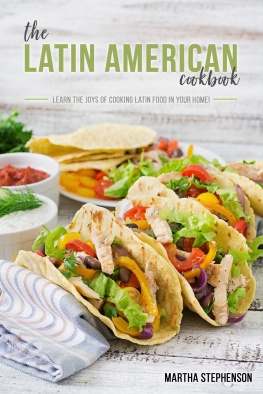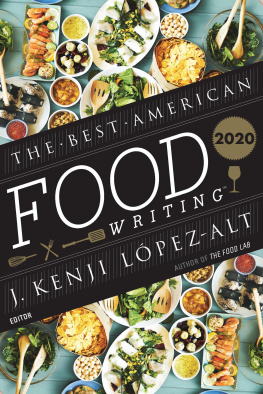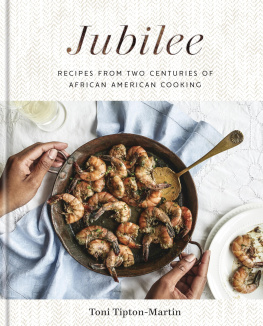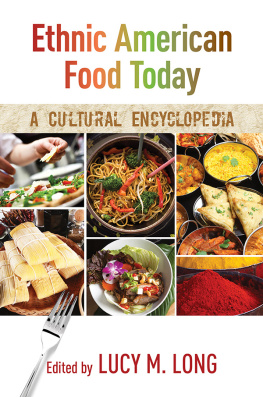Copyright 2017 University of Pennsylvania Press
All rights reserved. Except for brief quotations used for purposes of review or scholarly citation, none of this book may be reproduced in any form by any means without written permission from the publisher.
Published by
University of Pennsylvania Press
Philadelphia, Pennsylvania 19104-4112
www.upenn.edu/pennpress
Printed in the United States of America on acid-free paper
1 3 5 7 9 10 8 6 4 2
Library of Congress Cataloging-in-Publication Data
Elias, Megan J.
Food on the page : cookbooks and American culture / Megan J. Elias.
1st edition. / Philadelphia : University of Pennsylvania Press, 2017
Includes bibliographical references and index.
LCCN 2016055355 / ISBN 9780812249170 (hardcover : alk. paper)
LCSH: CookbooksUnited StatesHistory. / Food writingUnited StatesHistory. /
FoodUnited StatesHistory. / Food habitsUnited StatesHistory. /
Cooking, AmericanHistory.
LCC TX644 .E45 2017 / DDC 641.300973dc23 LC record
lccn.loc.gov/2016055355
I ONCE BOUGHT A secondhand copy of a Fannie Farmer Cookbook in which a previous reader had written and underlined the word no next to a recipe for soft custard. I myself have since made clear my allegiance to a particular chocolate pudding recipe through spine wear as I opened the book to it many times and through glops of batter dropped on the page, expressing my own version of yes.
The little direct evidence of cooking that occurs in physical cookbooks comes in the form of such personal annotations and stains. These marks do not often show up in archived cookbooks for the practical reason that libraries look for the cleanest copies they can get. Because of this, researchers seldom encounter this kind of evidence. Even when notes and stains show up, it can be difficult to know what to make of them. They can be read for clues to womens lives, but the stories they tell tend to be very particular. As in my case, I like Fannie Farmers Denver Chocolate Pudding quite a lot.
Cookbooks are full of words about food, but they dont really tell us what people eat. I first became interested in the history of American cookbooks when I realized this limitation. Trying to figure out what Americans had eaten in the past, I found that cookbooks could not tell me what I wanted to know. That certain recipes recur again and again over a generation or more both on restaurant menus and in cookbooks may suggest that someone has cooked them, but there is no way to be sure.
In other words, cookbooks, like any other genre of literature, have something to tell us about our times. When we encounter trends in literary genres, we seek explanations in historical contextromanticism in reaction to industrialization, for example. Equally, we look to see which previous traditions contemporary authors are drawing upon. It is time we did the same for food writing. Why were there so many books about Southern cooking after the Civil War? Why are there so many big pictures of raw vegetables in contemporary cookbooks? Why do such a lot of twenty-first-century cookbooks eschew somethingwheat or meat, for examplein times of plenty?
This book is about how American writers have defined their national foodways in cookbooks and magazines. In food studies, scholars commonly use the term foodways to refer to the combination of what people ate, how meals happened, and what diners thought about foodwhich dishes were considered normal, what materials were deemed edible, which preparations are appropriate to which groups. I trace how those definitions have changed over time, incorporating ideas from mainstreams and subcultures while also influencing cultures. When we read cookbooks for what they have to say about national foodways, we hear voices that have long been disregarded, the voices of people, many of them women, who understand that every meal is at once a cultural statement and a performance of self.
Examined from this perspective, cookbooks provide a lively range of opinions about and prescriptions for American food and, by extension, American culture. Each theme in cookbooks and each voice in this discourse emerges from a background of previous themes and voices. Tracing that genealogy, we can understand that ideas about food are not mere fads but instead part of an extended discourse that involves ideas about national identitywho is an Americanas well as what is good and bad taste. Contemporary critics identify some kinds of food as processed not because of any objective truth, for example, but because of how writers have defined the natural and the unnatural in American foodways over the course of the twentieth century.
Writing About American Food
Many different kinds of writers have written about American food, from the first European arrivals in North America, curious about what they could eat, to the latest food blogger reposting recipes with a tweak or two, to the historians, anthropologists, and sociologists who are now using food as a lens to understand American society.
Long before 1796, when the first cookbook was published in the United States, diary keepers and letter writers commented on foodpraising and criticizing individual cooks as well as what were perceived as national habits.
Englishman Andrew Burnaby, who toured the southern colonies during 1759 and 1760 found happier fare. He reported that soruses, a bird rather bigger than a lark, was such delicious eating, that when they were in season, you meet with them at the tables of most of the planters, breakfast, dinner, and supper. Because there was an inn in every town of the Northeast and a tradition of hospitality throughout the plantation colonies, letters and journals of travelers in the eighteenth and early nineteenth centuries were regularly punctuated with such commentary. While Knight complained of a single bad cook, Burnaby commented more generally on regional foodways.
Cookbook writers contributed to this conversation in America beginning in 1796 by producing a kind of literature that was both reflective and formative of their own culture. Cookbooks are typically categorized as
Words about food help us to understand what we are eatingis our blancmange correctly served?to place it in our particular cultural context, and to situate it in relation to what other people are eating. Words even help us to taste the food on our plates because we are creatures of culture, swayed by expectations and suggestive language.
It is common knowledge that the sense of smell is largely responsible for our experience of taste, but it is less commonly recognized that our interactions with words about food also determine how we taste what we eat. A study reported in 2013 by researchers at Cornell Universitys Food and Brand Lab offers evidence of the phenomenon. Participants in the study were given snacksyogurt, cookies, and chipsthat had been packaged with or without a label reading organic. The majority found the organic snacks tastier than those not labeled with the high prestige term, despite the fact that all were identical and all were organic. The concept is also familiar from the world of wine connoisseurship, in which the tradition of blind tastingnot being told anything about a wine before first tasting itderives from the fear that any kind of descriptors bias judgment.








